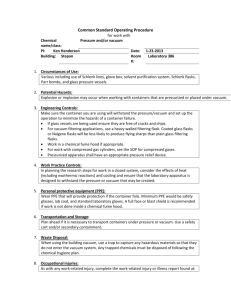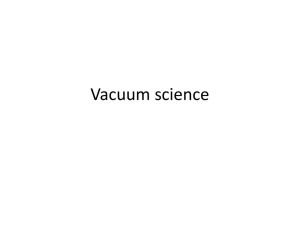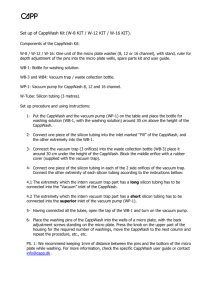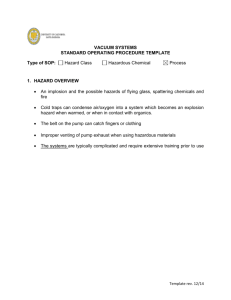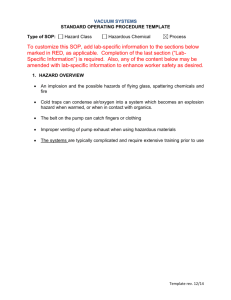Laboratory Vacuum Pumps
advertisement
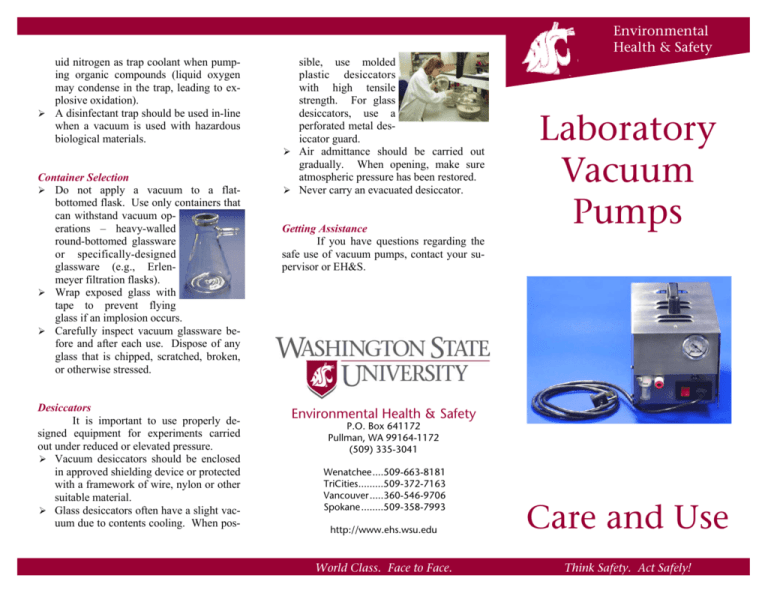
Environmental Health & Safety uid nitrogen as trap coolant when pumping organic compounds (liquid oxygen may condense in the trap, leading to explosive oxidation). A disinfectant trap should be used in-line when a vacuum is used with hazardous biological materials. Container Selection Do not apply a vacuum to a flatbottomed flask. Use only containers that can withstand vacuum operations – heavy-walled round-bottomed glassware or specifically-designed glassware (e.g., Erlenmeyer filtration flasks). Wrap exposed glass with tape to prevent flying glass if an implosion occurs. Carefully inspect vacuum glassware before and after each use. Dispose of any glass that is chipped, scratched, broken, or otherwise stressed. Desiccators It is important to use properly designed equipment for experiments carried out under reduced or elevated pressure. Vacuum desiccators should be enclosed in approved shielding device or protected with a framework of wire, nylon or other suitable material. Glass desiccators often have a slight vacuum due to contents cooling. When pos- sible, use molded plastic desiccators with high tensile strength. For glass desiccators, use a perforated metal desiccator guard. Air admittance should be carried out gradually. When opening, make sure atmospheric pressure has been restored. Never carry an evacuated desiccator. Getting Assistance If you have questions regarding the safe use of vacuum pumps, contact your supervisor or EH&S. Laboratory Vacuum Pumps Environmental Health & Safety P.O. Box 641172 Pullman, WA 99164-1172 (509) 335-3041 Wenatchee....509-663-8181 TriCities.........509-372-7163 Vancouver.....360-546-9706 Spokane ........509-358-7993 http://www.ehs.wsu.edu Care and Use World Class. Face to Face. Think Safety. Act Safely! Mechanical vacuum pumps used in laboratories pose common hazards. These are the mechanical hazards associated with any moving parts and the chemical hazards of contaminating the pump oil with volatile substances and subsequently releasing them into the lab. A few guidelines will help in the safe use of these devices. Vacuum System Vacuum systems pose severe implosion hazards. Follow these guidelines and requirements to ensure system safety: Ensure that pumps have belt guards in place during operation. Ensure that service cords and switches are free from defects. Do not place pumps in an enclosed, unventilated cabinet. Do not operate pumps near containers of flammable chemicals. Do not use solvents which might damage the pump. Always close the valve between the vacuum vessel and the pump before shutting off the pump to avoid sucking vacuum oil into the system. Place a pan under pumps to catch oil drips. Check oil levels and change oil when necessary. Replace and properly dispose of vacuum pump oil that is contaminated with condensate. Used pump oil must be disposed as hazardous waste. Conduct all vacuum operations behind a table shield or in a fume hood and always wear safety glasses. Always use a trap on vacuum lines to prevent liquids from being drawn into the pump, house vacuum line, or water drain. Traps When using a vacuum source, it is important to place a trap between the experimental apparatus and the vacuum source. The vacuum trap: protects the pump and the piping from the potentially damaging effects of the material, protects people who must work on the vacuum lines or system, and prevents vapors and related odors from being emitted back into the laboratory or system exhaust. When using a vacuum-filtration assembly, pay strict attention to the liquid levels in the trap bottle. Use a secondary trap bottle so that if liquid in the primary trap bottle reaches the inlet tubes, the liquid will be vacuumed into the secondary container instead of the pump. This will help reduce vapors in the atmosphere and expensive vacuum pump replacement costs. If you are directly vacuuming large quantities of gases over a long period of time, contact Environmental Health & Safety for assistance in identifying appropriate filters for minimizing vapor release. If a vacuum pump is required for lower pressures, the pump must be fitted with a cold trap to condense the volatiles. A cold trap is a condensing device to prevent moisture contamination in a vacuum line. When using a cold trap: Locate the cold trap between the system and vacuum pump. Ensure that the cold trap is of sufficient size and cold enough to condense vapors present in the system. Check frequently for blockages in the cold trap. Use isopropanol/dry ice or ethanol/dry ice instead of acetone/dry ice to create a cold trap. Isopropanol and ethanol are less expensive, less toxic, and less prone to foam. Use gloves when handling the dry ice. Do not use dry ice or liquefied gas refrigerant bath as a closed system. These can create uncontrolled and dangerously high pressures. Liquid nitrogen should only be used with sealed or evacuated equipment, and then only with extreme caution. If the system is opened while the cooling bath is still in contact with the trap, oxygen may condense from the atmosphere and react vigorously with any organic material present. Maintain a cold trap between a vacuum pump and the apparatus - do not use liq- 07/08/03


